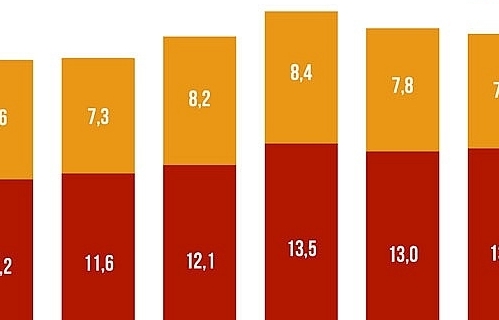Deep processing is the key to taking Vietnamese fruits to world markets
 |
| Mr. Dang Phuc Nguyen |
Could you share some of the key features of Vietnam's fruit and vegetable export results since the beginning of the year?
Vietnam's fruit and vegetable exports are on a downward trend. In July 2022, Vietnam's export turnover of fruit and vegetable was estimated at USD256.6 million, down 1.2% over the previous month and 3.4% over the same period in 2021. Accumulating seven months, export turnover is estimated at USD1,935.8 million, down 15.6% over the same period in 7 months of 2021.
In particular, the Chinese market - which accounts for 60% of Vietnam's export fruit and vegetable market share, recorded a sharp decrease of 34%, which had a great impact on the overall export results of the fruit and vegetable industry. China's implementation of the "Zero Covid" policy has caused many difficulties for countries bringing goods to China, including Vietnam.
As for the US market, although the statistical results show growth of 23% in turnover, during a recent survey to the US market, it was found that Vietnamese fruits are under great competitive pressure from countries such as Mexico, Peru, and Ecuador. Because of theirthe geographical proximity, fruits from these countries have much lower transportation and logistics costs to the US than Vietnam, so the selling price is more competitive. For example, a whole jackfruit costs only about VND25,000/kg, rambutan is about VND50,000/kg and watermelon is about VND30,000/kg, equivalent to the selling price in the Vietnamese market. Currently, each year, Mexico fruit exports to the US are around USD7-8 billion.
In US supermarkets, Vietnamese fruits appear very rarely. As inflation is high, Americans tend to save and switch to buying cheap products. This makes it harder for Vietnamese goods to compete. Previously, Vietnam exported a lot of products such as dragon fruit, rambutan, mangosteen and litchi, though all faced great competition due to increased costs.
Although Vietnam's fruit exports to China have declined sharply, the good news is that many fruits such as durian and passion fruit have been allowed to be officially exported. Will this help revive export turnover in this market?
Previously, before China signed a protocol with Vietnam, Vietnamese enterprises exporting through this market had to go through a small-traffic route with many risks because they did not have contracts and could not promote Vietnamese fruits. The Chinese side also does not encourage this form of export. The congestion of agricultural products at the northern border in recent times is a risky reality of this form of informal export.
Now, with the ability to export officially, businesses can promote the promotion of Vietnamese fruits in the media, the purchase and sale also have a clear contract. In addition, the selling price for Vietnamese fruit will also be higher because Vietnamese enterprises do not have to go through many traders but can work directly with large Chinese corporations and supermarkets. This also creates a foundation for developing sustainable raw material areas, and forming standard packaging facilities, thereby improving product quality.
When businesses build a brand, a national brand will also be formed. Currently, each year, Vietnam only exports durian with about USD150 million, while Thailand exports to China USD3.5 billion. This shows that there are still great opportunities and official export is the catalyst for improving quality and increasing export turnover.
The issue of food quality, safety and hygiene for agricultural products and vegetables exported to fastidious markets has been discussed a lot, but why have shipments been returned or destroyed due to chemical residue?
About 1-2 years ago, when exporting to fastidious markets like the EU, many enterprises and manufacturers did not fully understand the regulations on quality, including regulations on the concentration of chemical residues. The EU's allowable residue level is very low, and even if it has been approved by other markets such as the US, it still does not reach the EU. There is also a situation where enterprises receive orders of 10 tons, but the standard planted output is only about 8-9 tons, so enterprises buy more outside to meet the quantity of 10 tons. The risk is that this part purchased from outside is not well controlled in terms of the farming process, so there may be residues, when the EU takes a sample to check it, it hits this part right away, so the shipment is returned.
Currently, businesses are much more cautious; they do not dare to buy outside products unless they understand their farming process. In addition, exporters to fastidious markets have been interested in building their own raw material areas, linking with cooperatives and large farms to apply standard farming processes. Since then, from the end of 2021 up to now, the situation of being reflected has decreased a lot and is no longer as common as before.
Deputy Prime Minister Le Van Thanh has just signed Decision No. 858/QD-TTg, approving the "Strategy to develop mechanization of agriculture and agro-forestry-fishery processing until 2030". This has the goal of developing modern agricultural product processing and meeting the needs and regulations of the consumer market; to turn Vietnam into a processing center for agricultural products ranked in the top 10 of the world's leading countries by 2030. How will this affect the fruit and vegetable industry in particular and agricultural products in general of Vietnam?
This decision is a testament to the foresight of the Government. For a long time, Vietnam's agricultural exports have been mainly in raw form, costing a lot of logistics costs, while the value content is not high, especially in the context of high fuel prices and the still raging Covid-19 epidemic. In fact, inflation in large consumer markets is a big disadvantage. A container of durian exports is more than half shell and seeds. If it can be processed into split durian or ready-to-eat products, one container of finished product will be equivalent to three containers of raw fruit as today, thereby reducing a lot of costs. “Lighter” in weight but will be “heavier” in value.
It shows that the promotion of deep processing is imperative to bring Vietnamese fruits to any place in the world. With this decision of the Government, many Vietnamese fruits such as durian, coconut, pineapple, and passion fruit will have the opportunity to increase in value. Many products that only require very simple processing are also popular in the market. For example, in US supermarkets, fruit products provided by Mexico are a combination of many types of ready-made, frozen fruits that are widely consumed. With only a moderate amount of money, consumers can enjoy a variety of fruits, which is very convenient. Enterprises should learn more about market tastes and start with simple products first when capital and technology capacity is limited.
I believe that with this new decision and the active participation of relevant ministries, fruit and vegetable processing activities and agricultural products will prosper, which brings a new face to Vietnam's agricultural export industry.
Related News

Coconut is expected to become a billion-dollar export item
16:40 | 01/11/2024 Import-Export

Lao Cai Customs sees a triple-digit surge in export-import turnover
10:37 | 02/11/2024 Import-Export

Linkage - the "key" to sustainable development of agricultural value chains
09:15 | 14/10/2024 Import-Export

Vietnamese fruits have room to penetrate deeper into the Chinese market
11:56 | 04/10/2024 Import-Export
Latest News

Hong Kong: A gateway for Vietnamese businesses to access the Greater Bay Area market
09:04 | 24/12/2024 Import-Export

UK a niche market for Vietnamese speciality coffee
14:11 | 23/12/2024 Import-Export

Vietnam-US trade thrives on effective mechanisms: trade counsellor
14:08 | 23/12/2024 Import-Export

Opening of overseas markets boosts coconut exports
13:59 | 23/12/2024 Import-Export
More News

Increasing consumption demand, steel enterprises face many opportunities
11:08 | 23/12/2024 Import-Export

VN faced with increasing trade defence investigations on rising protectionism
18:58 | 22/12/2024 Import-Export

Việt Nam expects to officially export passion fruit to the US next year
18:55 | 22/12/2024 Import-Export

UK’s carbon tax to affect VN exports
18:51 | 22/12/2024 Import-Export

Removing obstacles in granting certificates of exploited aquatic products
13:56 | 22/12/2024 Import-Export

Promoting agricultural exports to the Japanese market
13:55 | 22/12/2024 Import-Export

Agricultural exports in 2024 to exceed 60 billion USD?
13:53 | 22/12/2024 Import-Export

Seafood exports expected to exceed $10 billion in 2025: expert
20:28 | 21/12/2024 Import-Export

Top 10 Reputable Animal Feed Companies in 2024: Efforts to survive the challenges of nature
18:30 | 21/12/2024 Import-Export
Your care

Hong Kong: A gateway for Vietnamese businesses to access the Greater Bay Area market
09:04 | 24/12/2024 Import-Export

UK a niche market for Vietnamese speciality coffee
14:11 | 23/12/2024 Import-Export

Vietnam-US trade thrives on effective mechanisms: trade counsellor
14:08 | 23/12/2024 Import-Export

Opening of overseas markets boosts coconut exports
13:59 | 23/12/2024 Import-Export

Increasing consumption demand, steel enterprises face many opportunities
11:08 | 23/12/2024 Import-Export





